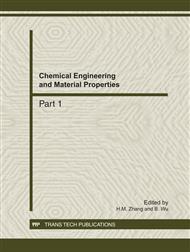p.1064
p.1069
p.1075
p.1080
p.1085
p.1090
p.1095
p.1100
p.1105
Effects of the Pre-Freezing Time on the Structures and Electrochemical Performances of Co-B Alloys
Abstract:
A series of Co-B alloys with uniform nanoparticles were prepared via a vacuum freeze-drying method, which the precursors of Co-B alloys were prepared by the reduction of bivalent cobalt chloride with aqueous sodium borohydride solution. The alloys were characterized by scanning electron microscopy (SEM), X-ray diffraction (XRD) and brunauer emmett teller (BET) surface area measurement. The electrochemical activities of Co-B samples were examined by charge-discharge test. This work studied the influence of pre-freezing time on the microstructure and electrochemical performance. The sample pre-freezing for 3 hours exhibits the best cycling performance than others, the discharge capacity increase to its maximum 438mAh/g, and it still remained 232 mAh/g after 60 cycles at a current of 50 mAh/g; while those of samples pre-freezing for 1 hour and 5 hours are 399 mAh/g and 413mAh/g, respectively.
Info:
Periodical:
Pages:
1085-1089
Citation:
Online since:
December 2011
Price:
Сopyright:
© 2012 Trans Tech Publications Ltd. All Rights Reserved
Share:
Citation:


